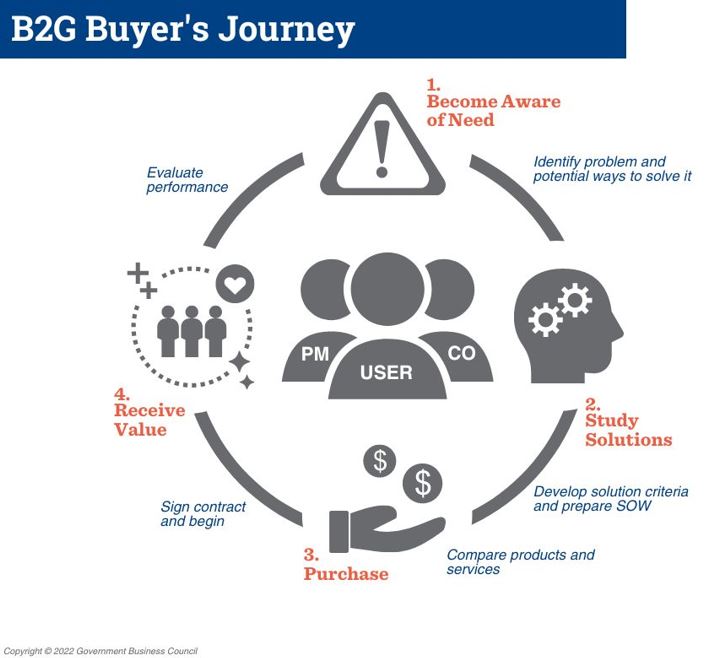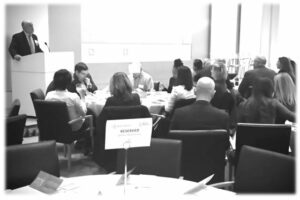Uncategorized
By Susan Rose, Senior Director, Insights & Content
I’ve been creating research-based thought leadership for the public sector for almost 20 years. Yet until fairly recently, it was unusual to connect each asset to the buyer’s journey. Or rather, unusual to actively talk about the buyer’s journey.
Over the years, nearly 100% of the assets I’ve created have been targeted to users who are just becoming aware of a problem. That makes sense because that is a sweet spot in the buyer’s journey where businesses can have an impact on creating solutions.
Isn’t that enough? The short answer is no.
I’ve seen my clients miss opportunities to engage with other influencers by focusing all their attention on one audience (users) in one stage of the journey (need).
While we can create valuable and interesting content focused on educating an audience about a specific topic, audiences have different needs depending on who they are and where they are in the journey when they interact with the content.
 An end user who needs a piece of technology to work in order to support the mission has different interests than a contracting officer who is putting together an RFP. They do not need the same information.
An end user who needs a piece of technology to work in order to support the mission has different interests than a contracting officer who is putting together an RFP. They do not need the same information.
The graphic shows a very simplified public sector buyer’s journey and where you have the opportunity to impact the buying decision. There are three general types of buyers in the public sector: the person who will use the product/service, the program manager, and the contracting officer. Each of these buyers is critical to the process, and each has different questions about what they’re buying.
What are those questions? Rather than guess, Market Connections decided to conduct a survey of federal buyers. We’re going to the source to find out how they navigate the buyer’s journey. We’ll be sharing the results at Government Marketing University’s GAIN conference on June 8th (click here for more information).
Until then, simply thinking about what stage of the buyer’s journey the target audience is in at the moment they will interact with the asset will help you create content that has more impact… and leads to more sales.
COVID-19 upended the way we do business, including in-person events.
 For over two years now, government contractors have wondered when and how federal events will get back to “normal”— shaking hands; networking; and seeing clients, vendors and colleagues face-to-face.
For over two years now, government contractors have wondered when and how federal events will get back to “normal”— shaking hands; networking; and seeing clients, vendors and colleagues face-to-face.
In the past year, attempts to have in-person events have happened in fits and starts. Surges in COVID cases and new variants partnered with government policies regarding event requirements all but pushed us completely back to virtual.
But federal employees are ready to get back to “normal.” Market Connections teamed with Government Marketing University to survey federal employees on their feelings about attending events for the upcoming training Fusing Gov’t & Industry: Event Go/No Go? Half of the respondents said they plan to attend in-person events this year. Of these, a majority, four out of five say they would attend one to three events in person, numbers that match what respondents said in 2019 before the pandemic.
For those focused on the defense market, the news is even better. Respondents across defense stated they were more likely to attend everything from micro- to large-scale events at higher percentages than their federal civilian counterparts. The success of the latest AFCEA West supports this finding. (Editorial recap of event success from fellow federal marketer Sheri Ascencio can be found here.)
Event Value Proposition
To host successful face-to-face events, we must change how we view them. A higher focus on the value proposition in attending is key. What will attendees gain from the event topic/content, speakers, opportunities for product demos and networking? These, along with logistics such as length, location, and requirements should all be considered.
When asked what drives event attendance in a 2019 event webinar survey, eight in ten respondents said the topic is the key driver. Nearly half mentioned networking opportunities and one-third mentioned the keynote speaker. One respondent said they attend events “(to) learn about technology, meet with vendors, meet other IT people, or (for an) interesting topic.” Another respondent from Homeland Security had a similar response: “(To) expand my knowledge and understanding of the topic.”
According to the 2021 Content Marketing Review, even in the midst of COVID, events (both virtual and in person) top the list (81% of federal respondents) as the most effective channel for disseminating content— topping search engines, email, corporate sites and news sites. These numbers further confirm that content is a key factor for the event strategy.
New Factors to Consider: Remote Work and Hybrid Events
In addition, COVID not only changed the way we met, but how and where we work. Today, 86% of federal employees work remotely at least part-time and over half work remotely full-time. This reality begs the question of whether government employees will be willing to attend an in-person event on a day they work from home, or on one of the only days that they come into the office. In short, what would drive them to step away to attend in-person?
Some event organizers are responding to this question by considering a hybrid event format. Yet there is fear that hybrid events will cannibalize the opportunity to meet with customers in person, historically the best way to forge strong relationships.
The bottom line is event organizers want attendees to come in-person. What can you do to drive attendees to make that decision rather watching comfortably from their couch?
To answer this and other questions on event drivers, deterrents, and the future of federal face-to-face events, attend Government Marketing University’s latest training, Fusing Gov’t & Industry: Event Go/No Go? and set your 2022 events up for success.
 FEDERAL MARKETERS MUST STAY ABREAST TO REACH TARGET AUDIENCES
FEDERAL MARKETERS MUST STAY ABREAST TO REACH TARGET AUDIENCES
It’s no surprise to anyone that the way we are seeking and receiving news has been changing and evolving. Gone are the days of starting your morning off with a coffee and newspaper, listening to news radio on the way to work or waiting for the 6 or 11 PM evening news. Over the years, news media has evolved to include blended online/print publications, 24-hour news stations, online news, and more recently, online social media and cell phone notifications.
Recent events and changes to the workplace have only accelerated the change. Federal marketers, like many others, must respond and adapt to these changes or else get left behind.
Many External Factors Affect Federal News Consumption
In years past, we have focused our Federal Media & Marketing Study on media channel preferences and the level of trust and confidence in those media properties. In many areas, 2020 was an accelerator, with both the onset of COVID19 as well as historical elections. The impact of the year’s events on the amount of news and the sources relied upon were reflected in the 2020 study results of federal respondents, including:
- Dousing the firewalls. Federal respondents’ ability to telework improved access to previously blocked sites on personal devices throughout the day.
- Shrink in the ink (including industry print). Most print publications were delivered to workplaces and passed along to colleagues. With employees working remotely, many lost access to these resources.
- Drive time crash. Remote work affected “morning drive” listenership negatively and likely will into the future; however, we heard anecdotally that listenership did spread and increased throughout the workday.
- Say her name. Daily radio listenership showed increases, potentially attributed to news radio being available streaming and easily summoned via Alexa/Google.
- Sourdough recipes and the news. Federal employees could access social media on personal devices throughout the day. LinkedIn, Instagram, Twitter and Reddit usage increased significantly in 2020. Pandemic updates and a historic election year, with candidates and campaigns communicating much more via social media channels, put social media front and center.
- Skeptics abound. There was also a significant decline in confidence across media outlets in 2020. Political polarization and concern with media bias continued.
Feds, like the rest of us, are affected by extenuating factors. Marketers must not always rely on tried-and-true methods of the past but keep an eye on the horizon and make necessary pivots based on data available.
What Should Federal Marketers Pay Attention to in 2021?
We’ll continue to look at trends and impacts on federal employees’ media usage, preferences, new and upcoming channels, and NEW THIS YEAR, where feds go for their local and breaking news.
Where federal employees go for local news can prove to be useful in building a tailored media plan across the country. A better understanding of “go-to” news sources and trusted news channels can put your message where their mind is. This may be the place to concentrate both paid and unpaid media and marketing efforts.
Need data to help make informed media purchasing decisions? Our 2021 Federal Media & Marketing Study provides the information you need.
Need more custom research to learn about your customer’s needs, challenges, barriers, perceptions and preferences, contact us to see how we can help.
 Is your marketing budget shrinking faster than you can blink an eye? You’re not alone. In this economy, many organizations are looking for ways to both reduce their research investments and get a greater return from them. Right now, it’s more important than ever to ensure a research project will maximize the learnings you need to enhance the performance of your marketing or operations. But don’t worry, because with a little effort, you can get more bang from your research buck. We’ll show you how. Click here.
Is your marketing budget shrinking faster than you can blink an eye? You’re not alone. In this economy, many organizations are looking for ways to both reduce their research investments and get a greater return from them. Right now, it’s more important than ever to ensure a research project will maximize the learnings you need to enhance the performance of your marketing or operations. But don’t worry, because with a little effort, you can get more bang from your research buck. We’ll show you how. Click here.
